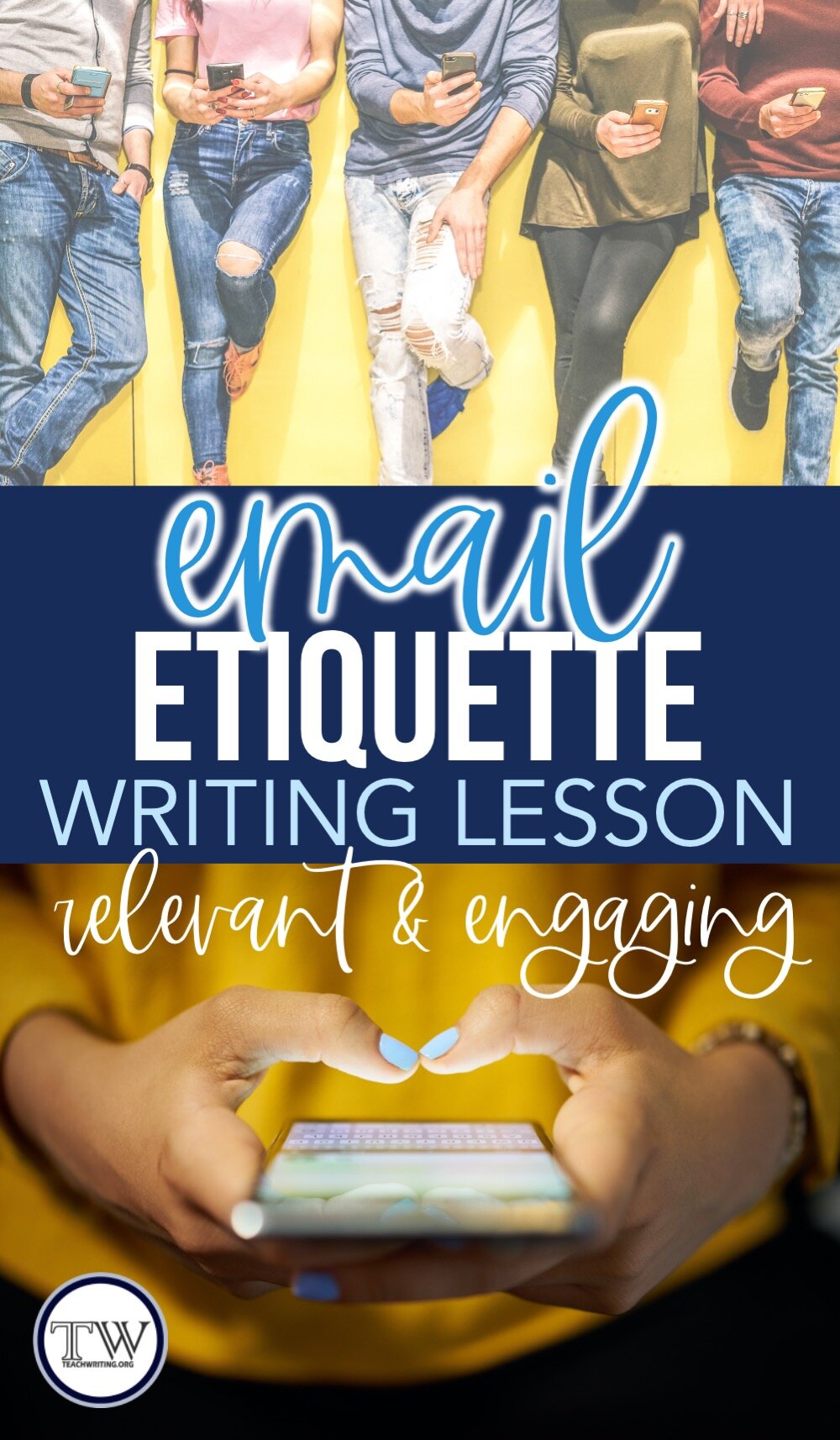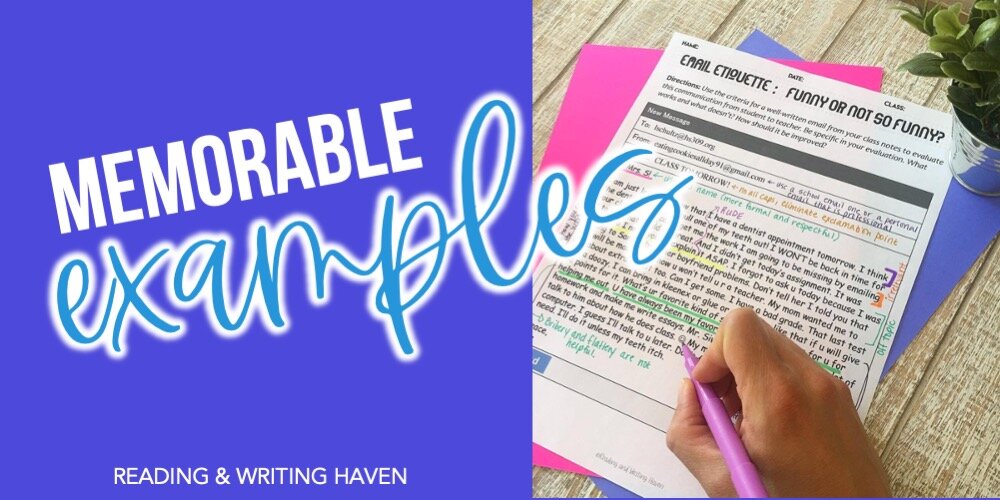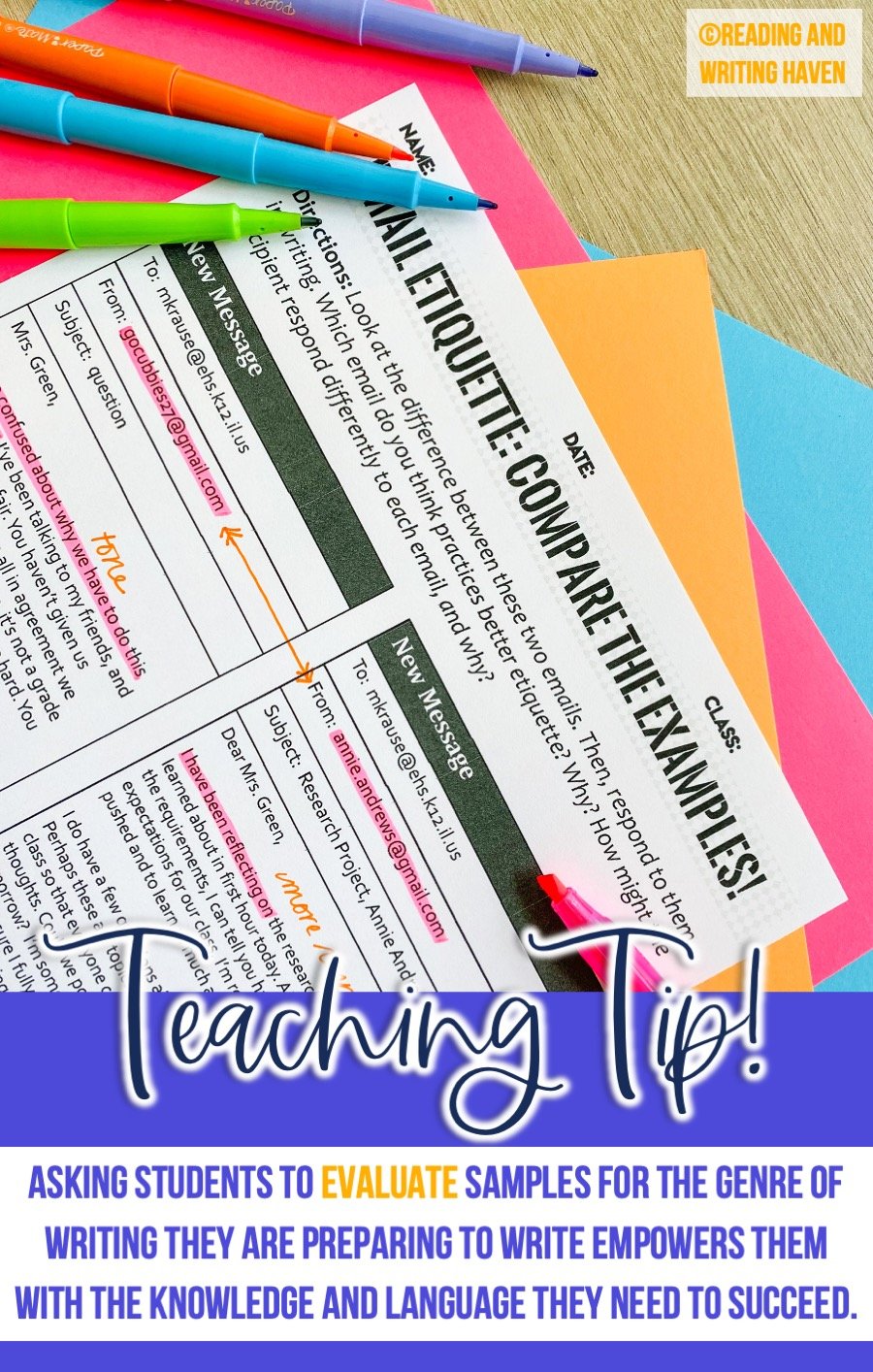The Best First Writing Lesson of the Year: Email Etiquette 101
Mrs. Kinsley,
Why didn't you put in my late work yet? I turned it in 7th hour today, and my dad is on my case. I'm going to be grounded all weekend if you don't put it in asap. Did you lose it?
Pete
[Insert sigh of frustration.] Emails like these are all too common at the secondary level. I used to get upset after reading one. I'd think, The nerve! How disrespectful. Stewing over it got me even more worked up.
One day as I was reflecting on this epidemic, it dawned on me. They've never been taught. And it's true. Many students who sit in our classes year after year have never been taught how to write an email to a superior (boss, teacher, or anyone else who would be addressed in a high-register tone).
So. I started teaching email etiquette. And guess what? Lo and behold...it worked. While teenagers are still learning how to master tone (we have to give them a little leeway and use teachable moments when they arise), we can't expect teens to be able to respectfully communicate with adults in a language that is somewhat foreign to them if we don't give them the tools to do so.
WHY TEACH EMAIL ETIQUETTE
First and foremost, no one appreciates receiving a rude email. Enough said.
However, it's also a form of communication that is highly valued in our society, both in personal and professional realms. Did you know that 99% of email users check their mail daily? Most of these individuals refresh their inboxes multiple times a day. No doubt, it's a dominant way humans speak to one another in a digital world.
In the academic setting, explicitly teaching students about email etiquette provides background students will need to discuss author's tone and writer's voice throughout the year.
Beyond high school, secondary teachers need to empower students to succeed in college and the workplace. One day, they won't have anyone to teach them how to write an email that conveys their message respectfully. We need to seize the opportunity while we can and set the stage for success in life.
Then there's relevance. Email etiquette is a skill in which students should find value. Often, we hear, Why do we even have to learn this? When are we ever going to use this in life? With this topic, students should see the direct connection to their lives and understand how much it will benefit them.
Finally, there’s winning the undying gratitude of your colleagues. That’s right. They will thank you because you are not only solving your email issues, but theirs as well.
WHEN TO TEACH EMAIL ETIQUETTE
While email etiquette could be addressed at any point during the year, I always use it as my back-to-school writing unit. In doing so, I experience fewer unpleasant communications during the remainder of the year, and students benefit by knowing how to confidently email their teachers all year long.
In middle and high school, students begin to email their teachers more frequently, so these are the ages where this type of lesson would be crucial. Because email genre is one that transcends subjects, it lends itself well to cross-curricular study opportunities.
TEACHING ETIQUETTE: 4 BEST PRACTICES
1. Establish criteria.
How is a student to know what is acceptable and what is not without a list of guidelines? I begin my email etiquette unit with practical tips that teenagers can apply to their own writing in order to sound more professional and respectful. At first, we use the tips I introduce to them, but soon enough, students are adding onto that list with some ideas of their own. And I love it! From there, we move on to evaluating texts based on those criteria.
2. Use engaging examples.
Most students have probably broken one or two etiquette rules in the past. The last thing I want to do when covering a subject like impolite emails is resort to shaming, so I keep it light. I use humorous (and often over-the-top) #EmailFail examples mixed with more down-to-earth and realistic ones. As a class, in small groups, and individually, we read, analyze, evaluate, discuss, and revise the model texts. Supplementing with video clips is an additional way to differentiate and make the content more interesting to twenty-first century learners.
3. Provide an authentic audience.
It's difficult for students to truly take a writing assignment seriously if they don't have an authentic audience. A best practice with writing is to have the students actually send the email to the recipient. In doing so, I'd strongly encourage you to either make yourself the recipient of an email in response to a fabricated scenario or to read through students' drafts before allowing them to press "send" to another teacher (for obvious reasons).
In the past, I've asked students to think of a class they have strong feelings about in the moment. (We need to harness real emotions in order to help students understand how to channel and word them respectfully.) Maybe they are angry because the teacher just assigned a large project. Perhaps they are worried because it's a speech course, and they are deathly afraid of public speaking. Or it could be that they just hate math...have always struggled with it...and are concerned about being pushed too far out of their comfort zone. I then ask them to draft an email to the instructor of that course, which leads us to best practice #4.
4. Give immediate feedback.
The easiest and quickest way for students to learn what's acceptable and what's not is if I go over their draft with them right then and there. I read it out loud so we can both hear it as the sender would interpret it. This way, their intended tone is not apparent, and I point out areas for improvement. For example, in her email, my student Jacky might have written something like:
Conferencing with students gives us a safe place to have conversations about an aspect of a student's writing that needs improvement without making them feel like they are a "bad" writer. It also allows us to discuss in detail the more advanced elements of writing, like tone.
Dear Mr. Stine,
I was wondering if you'd be willing to move the science test back another week? I have been studying on my own, but the study guide you provided is not very helpful, and I don't feel like we've covered the information well enough in class. Some of my friends have also expressed similar concerns, and we all think an extension of the test date is in order.
Thanks,
Jacky
While Jacky's email might follow a lot of the obvious, more minor guidelines for email etiquette, I would conference with her about how she could word her concerns in a tone that would win the audience over to her side rather than alienating the instructor by putting him on the defensive.
The number one comment I find myself repeating to students as I conference is this: Would you say this to their face? No? Then we need to word it differently in writing. Like text messaging or commenting on social media, it's easy to make hurtful and even mean remarks when you're separated from the audience by a digital wall.
Year after year, parents report to me that immediate feedback through conferencing is the number one factor in helping their children grow as writers. It's in this safe place that we can be honest, we can provide real-time feedback, and students can make improvements to their writing.
USING EMAIL WRITING AS A PRE-TEST
No one wants to start the year with a stack of papers to grade. Actually, people generally don't like stacks of paper at any time of the year. Yet, in order for students to really understand email etiquette, they need practice and repetition. So. How do we grade it without overwhelming ourselves?
We can start by asking a simple question: What's the purpose of this unit? In short, the goal is to help students communicate more politely in writing. What's the best way to teach them? In class - through practice and conferencing. Therefore, most of the "grading" takes place through discussion.
Teaching students about email etiquette doesn't have to add to equate to a mountain's worth of grading. Plus, by allowing students a free space to experiment, be vulnerable, and receive feedback that doesn't hurt their grade, an invaluable risk-taking platform develops; consequently, it creates a writing culture in which students feel confident and free to toy with their skills.
Many teachers begin the year with pre-tests, and I have as well. Formal writing pre-tests have value, but I find them more appropriate in small-group settings, for intervention, or with tutoring. Besides, trying to grade a stack of essays (even in the form of emails) at the beginning of the year is overwhelming. It's not fun to start the year feeling behind.
Since the goal of pre-tests is to help teachers gear their writing instruction, teachers can use email etiquette lessons to inform their future writing instruction. As you read students' email drafts and conference with them, you can keep a list of common errors you notice and use this information, which is gained in an authentic way, to decide where you want to begin your formal writing lessons.
Remember poor late-work Pete? What if his email had sounded like this?
Dear Mrs. Kinsley,
I am so sorry for not turning in my "Interlopers" reading guide on time. It's my responsibility. I submitted it at the end of the day today, but I didn't see you in your classroom. I just want to make sure you received it. Can you verify? Thanks so much in advance for your time in responding, and I apologize for the inconvenience.
Sincerely,
Pete
Do your students have any experience with writing formal emails to teachers, bosses, or other superiors? Do you receive emails from students which could be more professional? Will your students be applying for a job one day? Students of all subject areas and grade levels can benefit from some engaging #EmailFail and Email Etiquette 101 lessons. Let's help ourselves by helping our students hone real-world writing skills that will give them a competitive edge. You might be surprised how many of your students will thank you in return.
(Find the digital version of this unit made for Google Drive here. OR, you can grab both the print and digital versions of this career readiness writing unit right here. )
ABOUT THE AUTHOR
Melissa is the creator of Reading and Writing Haven and a collaborative blogger on Teachwriting.org.
An English teacher for over a decade, Melissa is an avid reader and writer, and she loves sharing ideas and collaborating with fellow educators. Melissa use her degrees in English and Curriculum & Instruction as well as her Reading Specialist certification to dive into today’s educational issues while developing resources to help teachers, students, and parents make learning more relevant, meaningful, and engaging.
LET'S CONNECT!







